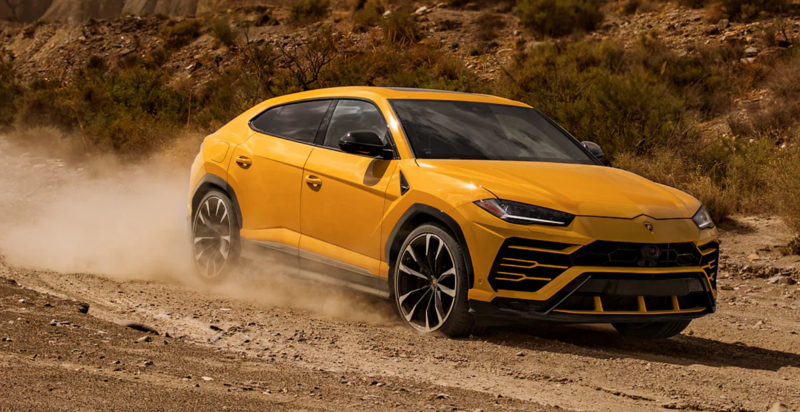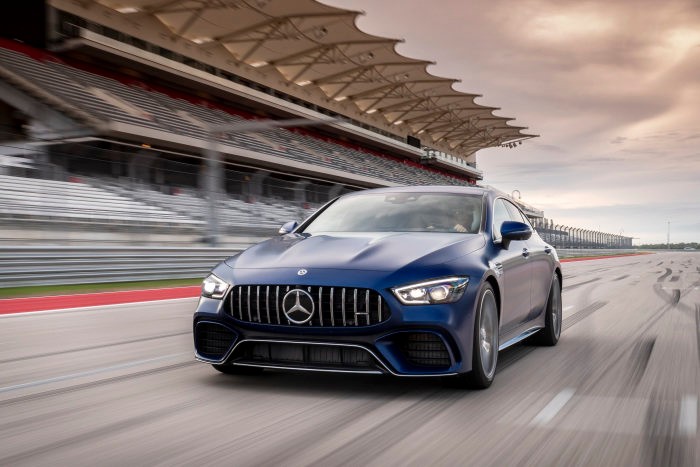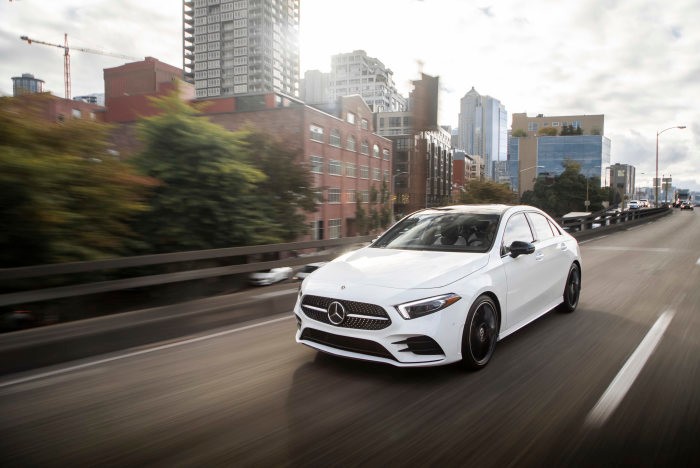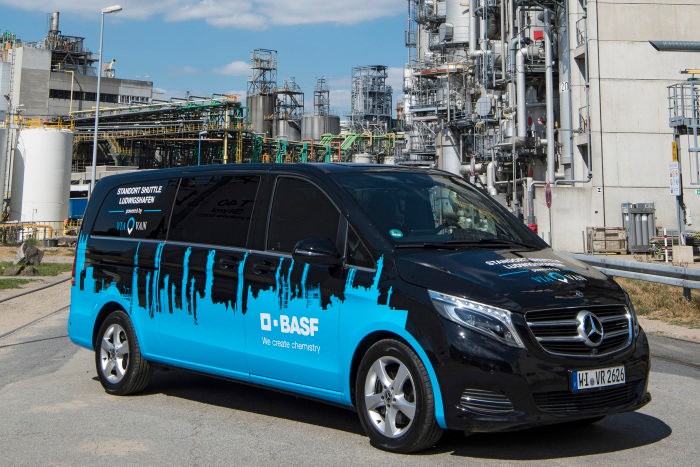These can be used to show content from a related smartphone app. “The Forease embodies a refreshingly simple form of driving fun in the city, standing for urban electric mobility without compromise,” said new Smart boss Kartin Adt. The EV powertrain is a nod to the future direction of Smart, which will become an electric-only… Continue reading Smart Forease concept revealed
Tag: Daimler
Lamborghini sees India among top 10 global markets in 5 years
PUNE: Italian super sports car maker Automobili Lamborghini expects India to break into its top ten global markets in the next five years with its new SUV Urus, set to help drive up volumes in the country, a top company official said Thursday. The company, which sold 26 units in India last year, expects to… Continue reading Lamborghini sees India among top 10 global markets in 5 years
IONITY Launches First 10 Ultra-Fast Charging Stations
2 H BY MARK KANE 10 stations ready, 390 more to come. IONITY in Europe proceeds with installations of ultra-fast charging network in a similar time/pace as Electrify America in the U.S. IONITY just completed its 10th station, while Electrify America had 10 in August. The IONITY is a joint venture of BMW Group, Daimler… Continue reading IONITY Launches First 10 Ultra-Fast Charging Stations
Mercedes-AMG GT 4-Door Coupé: A class of its own
26.
September 2018
Affalterbach
Press Contact (2)
Birgit Zaiser
Manager Communications Mercedes-AMG
birgit.zaiser@daimler.com
Tel: +49 7144 302-581
Fax: –
Koert Groeneveld
Head of International Product & Technology Communications
koert.groeneveld@daimler.com
Tel: +49 711 17-92311
Fax: +49 711 17-94365
Fuel consumption combined: 11.3-9.4Il/100 km; combined CO2 emissions: 257-215 g/km*
Download
Filter
Do you really want to delete the data record?
Please wait a moment …
Please wait a moment …
Please wait a moment …
Please wait a moment …
Highlights of the Mercedes-AMG GT 4-Door Coupé
Affalterbach, Sep 26, 2018
Mercedes-AMG GT 4-Door Coupé: A class of its own
Affalterbach, Sep 26, 2018
Engines: Six and eight-cylinder units offering a broad performance spectrum
Affalterbach, Sep 26, 2018
Transmission: With wet start-off clutch or torque converter
Affalterbach, Sep 26, 2018
Powertrain: Fully-variable all-wheel drive
Affalterbach, Sep 26, 2018
Drive programs: Up to six options suitable for all types of driving
Affalterbach, Sep 26, 2018
Suspension: Numerous motorsports elements ensure dynamic driving
Affalterbach, Sep 26, 2018
Lightweight construction principle: High percentage of aluminium and carbon-fibre components
Affalterbach, Sep 26, 2018
Exterior design: Typical AMG GT proportions and dynamics
Affalterbach, Sep 26, 2018
Aerodynamics: Fine-tuned interplay of active elements
Affalterbach, Sep 26, 2018
Exterior Packages and light-alloy wheels: A look to suit your every wish
Affalterbach, Sep 26, 2018
Interior: Incredible inner values
Affalterbach, Sep 26, 2018
The new Mercedes-AMG GT 63 S 4MATIC+ Edition 1: Even more individual flair for the AMG GT 4-Door Coupé
Affalterbach, Sep 26, 2018
Technical data
Affalterbach, Sep 26, 2018
Loading
BMW warns of lower profits on new emissions rules and an escalating trade war ‘distorting demand’
Andreas Gebert | Anadolu Agency | Getty Images
A visitor of BMW World walks past a BMW car during the annual accounts press conference of German car manufacturer BMW at the BWM World in Munich, Germany.
BMW said Tuesday its 2018 sales and profits will likely fall due to the costs of implementing new emissions standards in Europe and rising uncertainty stemming from the escalating global trade war.
Automotive revenues are now expected to fall slightly from the 88.6 billion euros ($104.4 billion at the current exchange rate) it generated last year, the company said. It previously told investors sales would rise.
BMW had also previously forecast profits to be on par with last year, but now expects a “moderate decrease,” the company said. The company earned 10.7 billion euros ($12.6 billion at the current rate) in 2017.
“The continuing international trade conflicts are aggravating the market situation and feeding uncertainty,” BMW said in a statement. “These circumstances are distorting demand more than anticipated and leading to pricing pressure in several automotive markets.”
The German automaker also said the industry's shift to a new laboratory test for emissions, the Worldwide Harmonised Light Vehicle Test Procedure, has created “supply distortions in several European markets and an unexpected intense competition.”
BMW had already expected 2018 to be a challenging year, due to the more than 1 billion euros in investments it is making in mobility, along with currency headwinds.
Fellow German automaker Daimler had warned at the end of July that the heightening trade war between the U.S. and China could affect its profitability this year. Both automakers have factories in the United States, where they build vehicles for both the U.S. market and for export.
The new Mercedes-Benz A-Class Saloon: Compact point of entry to the world of premium saloons
25.
September 2018
Stuttgart/Seattle
Press Contact (2)
Markus Nast
Manager Communications Compact Cars
markus.nast@daimler.com
Tel: +49 711 17-96357
Fax: +49 711 17-79055289
Koert Groeneveld
Head of International Product & Technology Communications
koert.groeneveld@daimler.com
Tel: +49 711 17-92311
Fax: +49 711 17-94365
Fuel consumption combined: 6.7-4.3 l/100 km; combined CO2 emissions: 153-113 g/km*
Download
Filter
Do you really want to delete the data record?
Please wait a moment …
Please wait a moment …
Please wait a moment …
Please wait a moment …
The new Mercedes-Benz A-Class Saloon: The main points at a glance
Stuttgart/Seattle, Sep 25, 2018
Compact point of entry to the world of premium saloons
Stuttgart/Seattle, Sep 25, 2018
Exterior design: superior sportiness and modernity
Stuttgart/Seattle, Sep 25, 2018
Interior design: revolution from within
Stuttgart/Seattle, Sep 25, 2018
MBUX Mercedes-Benz User Experience: unrivalled experience
Stuttgart/Seattle, Sep 25, 2018
active and passive safety: Intelligent Drive
Stuttgart/Seattle, Sep 25, 2018
Drive system: The heart of an athlete
Stuttgart/Seattle, Sep 25, 2018
Equipment/technology highlights: And you can get that in a compact car?
Stuttgart/Seattle, Sep 25, 2018
Production and sales: Even more global
Stuttgart/Seattle, Sep 25, 2018
Technical data
Stuttgart/Seattle, Sep 25, 2018
Loading
The auto industry’s VHS-or-Betamax moment
5GAA | 5G Automotive Association e.V via AP Images
In this image released July 11, 2018, 5GAA, BMW Group, Ford and Groupe PSA exhibit the first European demonstration of C-V2X direct communication interoperability between multiple automakers.
The auto industry has a choice to make: Which language will cars speak when they talk to one another?
Until a couple of years ago, automakers agreed on one vehicle-to-vehicle communications platform, called dedicated short-range communications, or DSRC, based on the technology used for Wi-Fi. But some car companies have begun to favor a competing protocol, known as Cellular V2X, which is based on a next-generation version of the technology used by your mobile phone.
So far, the federal government has held back on enforcing a standard. A proposed rule mandating deployment of DSRC equipment in new vehicles has languished for nearly two years, and critics say the delay is making motorists less safe. But supporters of the competing standard say something better has come along.
More from The New York Times:
Cars will talk to one another. Exactly how is less certain.
You don't drive a minivan? You should. Here's why.
Motorcycle makers try minting new riders with youth programs
“You've got public agencies who want to deploy, but we don't have a standard, so what do I buy?” asked Kirk Steudle, director of Michigan's Department of Transportation and a supporter of the DSRC standard. “Betamax, or a VHS?”
It is a crucial technological choice: Cars are increasingly connected, and the autonomous vehicles that will arrive in the future must have a way to communicate with each other and surrounding infrastructure. But even before self-driving cars hit the streets en masse, there are enormous benefits to be had. Federal transportation officials estimate that, once widely deployed, such communication systems will prevent or mitigate up to 80 percent of all non-impaired collisions and address thousands of fatal crashes per year in the United States.
The auto industry is divided over the standards.
General Motors has embraced DSRC, and it's already a standard safety feature on Cadillac CTS sedans. Toyota and Volkswagen have also committed to make DSRC systems standard equipment on new cars beginning next year. On the other side are brands, including Ford, BMW and Mercedes-Benz, that have joined the chip maker Qualcomm, cellular providers and others to form the 5G Automotive Association, which is pushing the C-V2X standard.
Regardless of the standard that's settled on, vehicles will be able to directly communicate with one another, allowing them to warn of collisions even when drivers cannot see each other. And such systems will allow valuable safety information to be shared from other sources: Instead of a sign warning that “bridge ices before road,” the bridge can warn drivers when ice has actually formed, and traffic lights will be able to manage traffic to minimize delays and clear the way for emergency vehicles.
But there are important differences.
DSRC has been around much longer, and most car companies have developed and tested systems based on the standard. The Federal Communications Commission ruled that a chunk of the wireless radio spectrum would be restricted to the DSRC standard beginning in 2003, and in 2016 the Obama administration proposed a rule that would mandate phase-in of DSRC in new cars and light trucks starting in 2021. The National Highway Traffic Safety Administration said systems to prevent collisions at intersections alone could save some 1,300 lives a year.
John Kenney, director of the Toyota InfoTechnology Center, said his company was ready to move ahead with the DSRC standard. “G.M. is online, too,” he said. “Now, there's a potential risk that maybe it's not going to be DSRC. That just impedes deployment.”
Supporters of the C-V2X standard contend that DSRC is nearly two decades old, from a time when companies didn't imagine streaming video to children in the back seat of a crossover, or updating vehicle operating systems from the cloud. C-V2X's advocates say it would allow for more features, be more flexible and could use cellular infrastructure.
“People assume that just because something is here now and they've been working on it for 15 or 20 years, it will be here 15 years from now,” said Jovan Zagajac, technology manager in Ford's Connected Vehicle and Services group and a member of the 5G group's board. “Well, the world has changed.”
BMW's engineers, for example, see safety advantages if cars can communicate directly with personal devices like mobile phones.
“This will make it much easier to retrofit vehicles and also give the benefits of C-V2X to other vulnerable road users, such as cyclists and pedestrians,” said Joachim Goethel, the leader of BMW's 5G connectivity initiatives.
The division runs deep. This month, the Eno Center for Transportation, a nonprofit established by William Phelps Eno, the road safety pioneer whose work led to New York City's first traffic plan in 1909, published dueling opinion pieces on the standards. One was from a Toyota official supporting DSRC and the other from a Daimler official favoring C-V2X.
Despite the Obama-era proposal, which would require all new vehicles to include DSRC by 2023, the federal government hasn't moved to enforce a standard.
Heidi King, deputy administrator at the National Highway Traffic Safety Administration, said the Department of Transportation was “technology neutral” on communication protocols.
“While our past research has centered around DSRC — because that was the only technology available — we are also exploring other technologies, including Cellular V2X,” she said in an email.
The federal government also has authority over a crucial element of any system: the radio frequency on which it operates. Two members of the Federal Communications Commission recently informed Toyota that the agency was looking at “newer technology” — such as C-V2X — for the 5.9-gigahertz band that has been allocated to DSRC.
“By taking a modern look at the possibilities for wireless services in the 5.9 GHz band, we can support automobile safety, increase spectrum for Wi-Fi and grow the wireless economy,” they wrote in a letter to the carmaker.
The mention of “the wireless economy” hints at another crucial difference between the standards: DSRC has little possibility for monetization, while a cellular system offers the possibility of revenue streams through additional data services. The 5G Automotive Association suggests that next-generation infotainment services used by C-V2X — such as movie streaming or conference calls — would improve the passenger experience.
Car and equipment makers have conducted trials of C-V2X, but even its proponents acknowledge that it will take time to roll out, while DSRC is market ready. It's not just automakers that now have to wrestle with the choice: State transportation departments and many local authorities have been installing DSRC-compatible roadside infrastructure for almost a decade.
In January, 12 state and regional transportation officials, including Mr. Steudle of Michigan, formed the Coalition for Safety Sooner to advocate the protection of the 5.9 GHz band for DSRC and the acceleration of efforts to deploy it.
The group pressed its case in a letter to Transportation Secretary Elaine Chao; Ajit Pai, the chairman of the Federal Communications Commission; and Mick Mulvaney, the director of the Office of Management and Budget. The signatories had already installed or committed to install more than 1,000 DSRC-equipped intersections and roadside units, and outfitted thousands of their own vehicles with the technology.
“Waiting for the next technology solution to be developed, tested and proven misses a huge opportunity to potentially save tens of thousands of lives throughout the United States each year,” they wrote.
A recent study published by the University of Michigan Transportation Research Institute calculated the cost of waiting to deploy vehicle-to-vehicle systems. A three-year delay will allow the sale of millions of new cars and light trucks without them, and those vehicles will remain on the road for an average of 15 years. During that time, they would have millions of avoidable collisions, according to the study, which was written by James Sayer, the institute's director, and two other researchers.
The institute helped with one of the first and largest tests of DSRC technology in Ann Arbor, Mich., involving some 3,000 vehicles. Based in part on that experience, Michigan officials require DSRC-compatible hardware in every new traffic signal in the state.
Mr. Steudle, the ..
Audi plans Maybach-rivalling W12 A8 flagship
Audi is planning the return of the super-luxury Horch name, which will be used on a flagship A8 that could also mark the return of the VW Group’s W12 engine to the Audi line-up. Automotive News reports that the Audi A8 Horch will likely bring the W12 powertrain – currently only used in the Bentley range… Continue reading Audi plans Maybach-rivalling W12 A8 flagship
Mercedes-Benz Vans and BASF agree on cooperation in mobility – Starting with Corporate Shuttle by ViaVan
20.
September 2018
Stuttgart
Mercedes-Benz Vans and BASF plan to collaborate on mobility topics and work together to forge ahead with innovations. The two companies are starting their cooperation with the optimisation of individual mobility at BASF’s plant in Ludwigshafen, where they will shortly introduce an on-demand ridesharing system. Beyond individual transport on the factory premises, the partners also want to test solutions in electric mobility, digitalisation and autonomous driving.
The on-demand ridesharing system features vans that employees and guests can order for travel around the BASF site. The system runs via an app that determines optimum vehicle routes, and is intended to augment the existing timetabled bus services with the aim of reducing individual traffic on the site while simultaneously improving mobility.
The service will be operated and provided by ViaVan, a joint venture between Mercedes-Benz Vans and US based Startup Via. The intelligent algorithm developed by Via makes it possible to combine trips to transport passengers with the same or similar destinations together without tedious detours and delays. ViaVan is already operating in Amsterdam, London and Berlin, with other European cities set to follow. The BASF plant in Ludwigshafen is the first industrial site to introduce this system.
“The cooperation with BASF is a further milestone in our adVANce future initiative”, says Volker Mornhinweg, Head of Mercedes-Benz Vans. “It supports the rapid development of new mobility solutions – in the reality of everyday operations and in close collaboration with our partners and customers. Both, BASF and Mercedes-Benz Vans embrace innovation and change – ideal prerequisites for close dialogue and joint, ambitious projects. We are focusing initially on the optimisation of factory-site traffic – but that is just the start. With our solutions for shared and, in future, autonomous mobility, we will play a role in ensuring all BASF employees arrive at their destinations quickly, conveniently, safely and sustainably.”
Dr. Uwe Liebelt, President BASF European Site & Network Management and General Manager of the Ludwigshafen plant, says: “I’m delighted we have secured a partner as strong and innovative as Daimler for this project. We are embarking upon a development phase over several years starting with the ViaVan ridesharing service, which will focus on providing forward-looking mobility solutions for our employees. This will improve working conditions for our people and is very much in keeping with our “Zukunftsbild Werk Ludwigshafen” (Vision for the Ludwigshafen Site) project, namely to set an example in safety, productivity and innovation.”
Press Contact
Thomas Christian Rosenthal
Product Communications adVANce and Future Transportation
thomas_christian.rosenthal@daimler.com
Tel: +49 711 1740286
Fax: +49 711 1779029941
Press Contact Overview
Media
Download
Pictures (1)
Videos (6)
Documents (1)
Media Contact (1)
Filter
Show thumbnails
Show list
Slideshow
Zoom
Preview
Details
Do you really want to delete the data record?
Please wait a moment …
Please wait a moment …
Please wait a moment …
Please wait a moment …
18C0810_001
Loading
2018年03月28日 Daimler launches new DENZA… Daimler and its Chinese partner BYD continuously inves…
Daimler launches new DENZA electric vehicle for the Chinese market
2018-03-28 19:47 by 点击量:2544
Daimler and its Chinese partner BYD continuously invest in DENZA product development for China’s New Energy Vehicle (NEV) market
New DENZA electric vehicle brings a refreshed exterior design and extended range of around 500 kilometers
Locally sourced and produced, DENZA brand combines Daimler’s vehicle architecture expertise with BYD’s leading battery technology
Stuttgart / Shenzhen – Daimler and BYD Automotive Industry Co., Ltd. today launched the new DENZA 500 battery electric vehicle from their joint venture, Shenzhen DENZA New Energy Automotive Co., Ltd. Engineered and produced in and for China, the new DENZA 500 offers Chinese customers a comprehensive upgrade through a refreshed exterior design and extended electric range. The DENZA model combines Daimler’s vehicle architecture expertise and advanced safety engineering with BYD’s leading advantages in battery technology. Through continuous investment in DENZA product development, Daimler is dedicated to contributing to the further development of electric mobility in China.
The DENZA 500 adopts a refreshed and unique exterior design, featuring “tiger eye” LED headlights and rippling LED taillights, while inside sees a larger 9-inch touchscreen.
Upgraded connectivity services include charging solutions and the DENZA smartphone application. Via the DENZA application, WeChat account, or car navigation system, DENZA owners can quickly locate over 112,000 charging piles across the country. A new battery and additional weight reductions allow increased energy efficiency, providing an extended range of around 500 km. The new DENZA 500 was tested in a wide range of harsh conditions, including severe winter testing at temperatures of as low as –40 degrees Celsius.
In 2017, DENZA achieved its best sales performance to date, with retail sales volume increasing by 85% year-on-year, outpacing the industry average, thanks to the strong customer reception of the DENZA 400 model. The brand also expanded its reach through selected Mercedes-Benz dealer partners, which now offer sales and after-sales service for DENZA vehicles. Through cooperation with Chinese ride hailing platforms, DENZA has allowed even more Chinese customers to experience the brand’s environmentally-friendly mobility.
腾势微信号
腾势官方微信号(服务号和订阅号)为车主和消费者提供全面的线上服务,预约试驾、查询经销商、查找充电桩等服务让您畅驶无忧,车主论坛、活动专区更可以让您分享、体验更加缤纷多彩的纯电动生活,充分享受腾势纯电动驾乘乐趣。
腾势手机官网
使用手机扫描二维码,访问腾势手机官网。
腾势智能 APP
腾势为车主打造的智能APP,具有丰富的智能远程操控功能,让一切贴心周到。
主要包括智能远程控制、查询电量状态、智能充电地图、智能路线规划等功能。
多种人性化体验,让车主随时随地与爱车“智”趣联动。





